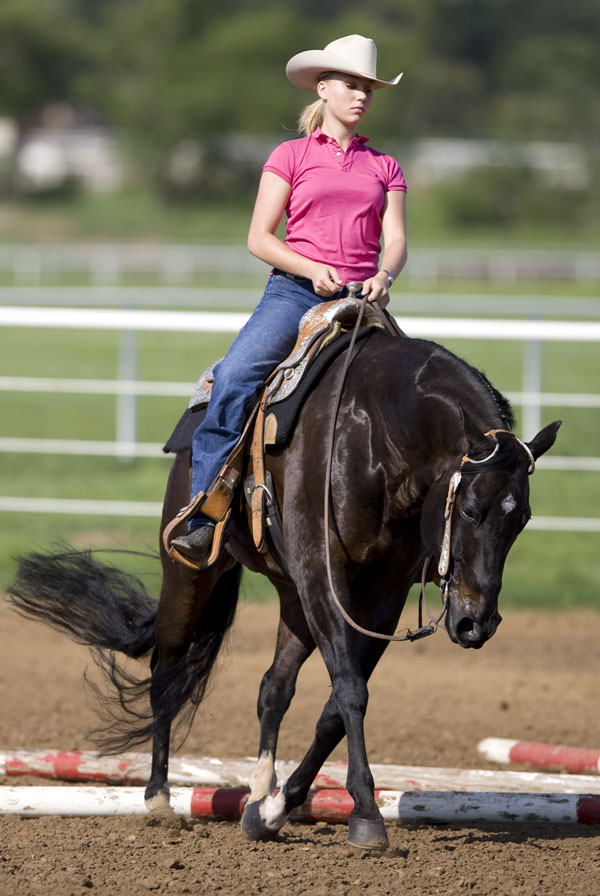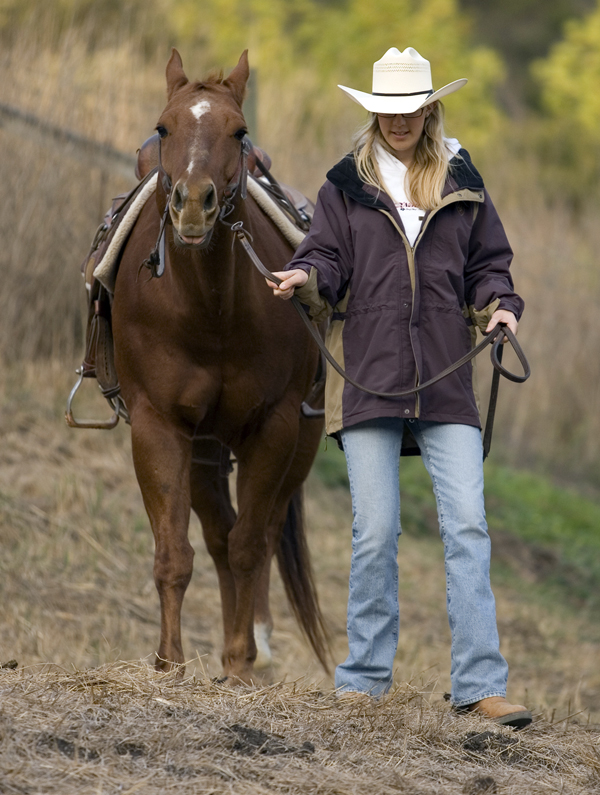
Looking to buy a horse? Found a real bargain? Slow down! Just because a horse is “a good deal” doesn’t mean he’ll be good for you. If he doesn’t match your needs in several key ways, he won’t make you happy—even if you get him for free.
I’m going to give you seven key criteria to consider before you make that important buying decision, plus—at the bottom of this page—a list of strategies to apply to any horse purchase.
Make good use of this information and you’ll increase the odds your next horse will be a pleasure to own and fun to ride.
Sound good? Then let’s get started, mate.
1. Is he a match for your riding ability?
This is the biggie, of course. The horse’s temperament and “brokeness” must match your experience and ability level as a rider and handler. The biggest mistake I see at my clinics all over the country is green, inexperienced people trying to work with green, inexperienced horses.
When you’re a novice, trying to learn on an inexperienced horse is the ideal way to destroy your confidence, set your training back, and put yourself in a position to get hurt.
Instead, select a horse that has a little age and maturity on him, with plenty of training and riding on his resumé. Well-cared-for horses can remain serviceably sound and rideable well into their teens and beyond, and many of the older ones are terrific confidence-builders.
Don’t tell yourself that you and a young horse will “learn together.” I have a saying about that: “Horses teach people, then people teach horses.” By that I mean, first buy one that already has the training and experience to teach you.
Then, much later, after you’ve had a chance to absorb what one or more seasoned horses can teach you, you can try your hand with a greener prospect or with starting a colt.
If you’re not sure what your ability level is, get evaluated by a professional. Take a few lessons with a reputable trainer, then ask him or her to recommend the type of horse that will work best for you. This person might also help you find that horse—more on that in “Smart-Shopping Strategies.”
[BUT FIRST: Do you have what it takes to own a horse?]
2. Will he suit your riding goals?
First ask yourself what you want to do with the horse. Take nice, quiet trail rides? Be competitive in Western pleasure or reining? Try your hand at barrel racing? Each of these warrants a horse with a different background of training and experience.

If trail riding is your main goal, for example, don’t let yourself fall in love with one that’s a “made” pleasure horse—but has never set hoof out of an arena. In other words, make sure the horse has been successfully doing what you want to do with him.
By the same token, if you’re buying a horse for your child, be sure the horse in question has been ridden by a kid in roughly the same age group as yours. A horse that’s great for an adult won’t necessarily be good for a child. Sometimes they are, but to be safe, try to find one that’s already been working as a child’s mount.
3. Do his energy needs match your riding schedule?
This one is often overlooked. Here’s how it goes: You look at a horse that’s in a six-day-a-week program, and he’s just as nice and quiet and well-mannered as can be. You buy him, bring him home, and put him on your schedule—that is, three days a week when you can manage it, and often just weekends. In a month’s time, the nice, quiet horse has turned into a nervous, high-powered wreck.

To avoid this pitfall, always ask what type of riding schedule the horse needs to be at his best. If what the horse needs differs from what you can give him, proceed with caution.
You might ask the owners to put him on that schedule, then go try him again later.
Here’s also where a trial or a lease-to-buy arrangement can be helpful. (Again, check that “Smart-Shopping” list at the bottom of this page.)
Above all, if you know you’re going to have just one or two days a week to ride and work with the horse, be absolutely sure you select a quiet one that’s already proven to stay sane and happy on that sort of schedule.
[RELATED: ‘Buy a horse,’ they said, so I did…]
4. Is his behavior consistent?
Obviously, you can’t answer this one if you only try him once, no matter how good he seems the first time you ride him. Go back and ride him as many times as you can, and in different settings.
Ask the owner to find another horse, if need be, so the two of you can go on a trail ride—ideally away from home base (because a lot of horses act much differently away from home than they do in their familiar stomping grounds).
Or, if showing is your main goal, ask the owner to bring the horse to a local schooling show, where you can ride him around the show grounds to see how he reacts in a show environment. If appropriate and the buyer is willing, you might also ride the horse in a class or two.
5. Is he willing, able, and happy to learn?
The best way to assess this quality is to try some training methods on the horse. Look for a good-natured willingness to attempt what you’re asking, rather than smooth performance.
In other words, if you try to flex his neck to the side from the ground, or back him out of your personal space, don’t worry if he seems a bit stiff or slow to respond. Instead, note whether he at least tries to understand and do what you’re asking, without getting sullen, cranky, or defiant.
Ideally, do this impromptu training on several different days, and see if the horse improves over time. If he does, and if he accepts the training without objection, then he’s likely a willing and good learner—a highly desirable quality.
[RELATED: Surprising source of good ranch horses.]
6. Will he lope quietly?
You wouldn’t believe how many people don’t lope a horse before buying him. Yet loping is so critical, not just to see how he lopes, but also as a measure of his overall training, willingness, and temperament.

You see, most horses feel some obligation to at least walk and trot, and will do so without much backtalk. It’s when you ask them to lope that chinks in their training or any latent naughtiness issues are likely to come out.
Obviously, start by having the owner lope the horse. If he or she won’t, it should be a deal-breaker, regardless of the excuse.
Then, if for any reason you don’t feel comfortable loping the horse yourself (because you want to get to know the horse more first), bring along someone who will.
Ideally, the horse should lope willingly and quietly, on the correct lead. If he can do it on a loose rein, even better.
Especially if you’re a timid rider, remember this: A lack of confidence almost always stems from a feeling of lack of control. When you feel you have control, you feel confident. And if you have a horse that lopes willingly and quietly from the get-go, you’ll feel in control of him.
[RELATED: ‘What horse ownership has taught me.’]
7. Will he pass a vet check?
A pre-purchase exam (or vet check) is important regardless of the horse’s asking price. That’s because you can get just as attached to an inexpensive horse as you can to a costly one, and any later vet care will cost as much as it would for a pricey horse.
Bear in mind, though, that every horse will have some negatives—especially those terrific, more mature confidence builders. The key is to talk to the examining veterinarian about what you can and can’t live with, based on your intended use for the horse. (And you may be able to negotiate a reduced price based on what the vet check turns up.)
On the other hand, if a serious, can’t-live-with-it problem turns up, don’t hesitate to reject the horse. Remember, there’s always another horse out there. This won’t be your only chance, so don’t buy yourself into a heartache.
(Ready to look for the right horse for you? First, don’t forget to go over the smart-shopping strategies below, then go to Equine.com, the premier classifieds site of the Equine Network, to search for your next great partner!)
SMART-SHOPPING STRATEGIES
• Get help. If possible, enlist the services of a trainer, or take an experienced friend horse-shopping along with you. The right trainer can take much of the guesswork out of your horse-buying decision, but only if you use someone you can trust and who stands behind his or her work.
Ask for references, and be sure to clarify in advance exactly how the trainer will be paid. A 10% commission on the selling price is fairly standard; what you want to avoid is an additional mark-up on the side. To be safe, write the purchase check directly to the seller, with a separate commission check to the trainer.
• Sleep on it. Take your time making that critical decision. Avoid an impulsive buy, especially in a buyer’s market, when there are plenty of horses available at good prices.
If, as you’re deliberating, the horse in question winds up selling to someone else, don’t worry; you’ll find another one.
If possible, make a video of you handling and riding the horse to take home and watch multiple times and show to others. Think it through.
• Be blunt, not bashful. Don’t assume anything; ask about any potential vices the horse may have—specifically, does he bite, kick, rear, strike, spook, bolt, pull back when tied, refuse to load into a trailer?
Then, as you try the horse, give him the opportunity wherever you can to reveal any vices (for example, ask to see him loaded into a trailer).
• Run from pressure. If the seller seems urgent, saying things like, “Better make up your mind, as I have someone else coming to see him later today,” get out of Dodge. Why? If the horse is truly as good as represented, the seller has no reason to pressure you. But if the horse has hidden faults, the quicker the seller can seal the deal, the better—before you discover what those faults are.
• Don’t be swayed by emotions. Let the horse’s suitability—not your heart—guide you. If you find yourself talking yourself into the horse, making excuses for telltale signs (such as ear-pinning) that should ward you off, hit the brakes. Those excuses are a clear sign your emotions are overruling your thinking.
Be especially careful when a horse happens to be your favorite color, or has some other relatively trivial quality that makes your heart race. Such bells and whistles can blind you to more important considerations—such as that tendency to kick.
Also, don’t take on a charity case because you feel sorry for him and want to “save” him. (If he’s that skinny or otherwise abused, report him to animal welfare.)
• Search broadly. Especially if you’re a novice, the fewer restrictions you put on the purchase in terms of your wants (the horse’s breed, age, size, color, markings, and so on) the better your chance of finding something that suits your needs. So be open-minded and willing to consider any good prospect.
Don’t get hung up on color and breed; get hung up on temperament and experience. (If you’re more experienced, you can be a little pickier in the “amenities” department.)
• Don’t think ‘forever’. Buy a horse that meets your current needs. When those needs change, you can trade up. For example, a good beginner’s horse is often a bit lazy and stiff. When you outgrow him, don’t try to change him into something he can’t be. Instead, find him another home where he’ll be loved and appreciated and can help someone else learn, then move up to a more suitable mount for yourself.
• Hedge your bets. The best way to make sure the horse is right for you is to take him on trial or a lease-to-buy arrangement first. Many sellers are not open to this option, but it can’t hurt to ask.
It may even be worthwhile to pay a premium for this option; in other words, negotiate a price, then offer to add $300 to $500 or so for the privilege of taking the horse home for a month first.
Expect to give the seller a post-dated check for the agreed-upon price (subject to renegotiation if something of concern shows up on the prepurchase exam). A short-term insurance policy may also be required, to protect both you and the seller in the event of the horse’s death or injury.






